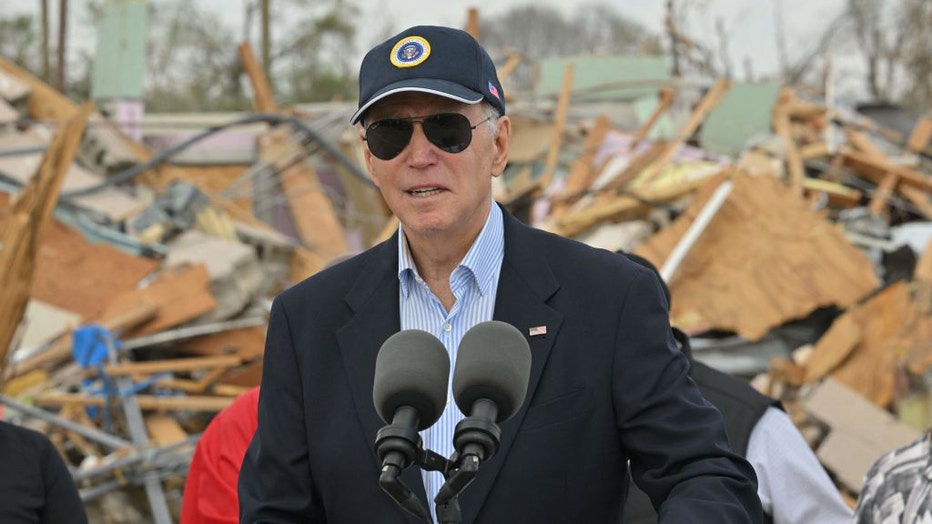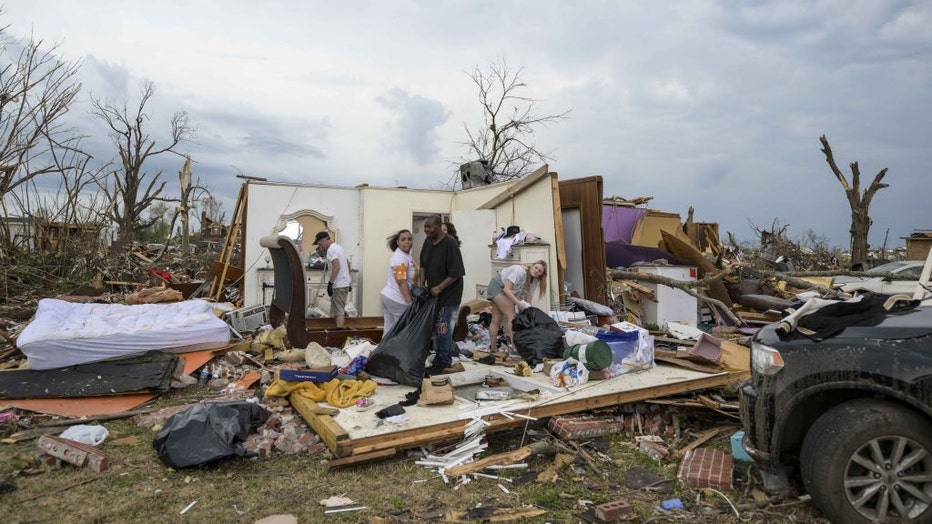Biden: Feds 'not leaving' Mississippi town hit by deadly tornado

Biden speaks from site of deadly tornado in Mississippi
President Joe Biden visited Mississippi after a deadly tornado hit the state, and said the federal government would cover the total cost of the state?s emergency measures for the next 30 days, in remarks on March 31, 2023.
WASHINGTON - President Joe Biden saw for himself the flattened homes, broken furniture, and children's toys left behind by last week's deadly tornado in Mississippi and vowed that the federal government is "not leaving" until the area is back on its feet.
The president arrived in the Delta community as a new series of severe storms threatens to rip across the Midwest and the South.
Last week's twister destroyed roughly 300 homes and businesses in Rolling Fork, and the nearby town of Silver City, leaving mounds of lumber, bricks and twisted metal. Hundreds of additional structures were badly damaged. The death toll in Mississippi stands at 21, based on those confirmed by coroners. One person died in Alabama, as well.
RELATED: How you can help survivors of Mississippi, Alabama tornadoes
From Marine One, as they flew from Jackson to the area hardest hit by last week’s storm, the president and first lady Jill Biden got a view of the devastation across acres of farmland — destroyed homes, toppled trees and piles of debris.
"This is tough stuff," Biden said as he was greeted by state, local and federal officials after arriving in Rolling Fork. "The most important thing is we got to let people know the reason for them to have hope, especially those who have lost somebody."

US President Joe Biden speaks in Rolling Fork, Mississippi, on March 31, 2023. (Photo by MANDEL NGAN/AFP via Getty Images)
The White House said ahead of his arrival that Biden will announce that the federal government will cover the total cost of the state’s emergency measures for the next 30 days, including overtime for first responders and debris cleanup. He's also expected to announce the Federal Emergency Management Agency will open disaster recovery centers in storm ravaged counties to help residents access the resources available to them.
The Bidens also met with residents impacted by the storms and first responders, and received an operational briefing from federal and state officials. They were joined by Gov. Tate Reeves, Sen. Cindy Hyde-Smith and Rep. Bennie Thompson.
Biden lost Mississippi by more than 16 percentage points in 2020, but residents were grateful that he decided to visit the devastated area and express his support.
Resident Paul Rice drove around Rolling Fork on an ATV vehicle to survey dismantled infrastructure and check on friends whose homes had been destroyed. Rice didn’t vote for Biden in the last election, but he welcomed the continued attention Friday’s visit brought to the town’s plight.
"Right now, everybody’s here, but I imagine it’ll start drying up," Rice said. "We’re Americans first and foremost. And that means we all have to work together."

Nine people sheltered from tornado in cooler
The owners of Chuck's Dairy Bar gathered their employees inside an ice cream cooler to escape a tornado. FOX Weather's Katie Byrne introduces us to the owner/survivor and shows us the cooler after the tornado destroyed the building.
Under a canopy set up blocks away from Rolling Fork’s obliterated city hall building, church volunteers doled out packages of breakfast sausages and pancakes with syrup Friday morning. Joseph Thomas, a 77-year-old Vietnam veteran and lifelong Rolling Fork resident, arrived to claim his meal wearing a bandana emblazoned with an American flag.
Thomas said he never imagined any president would come to his rural Delta hometown.
"I’m proud that he is coming to this little small town. That means a lot to me," Thomas said. "Because we need a lot of help to come through here, federal help, boots on the ground to put all this back together."
Presidents regularly visit parts of the U.S. that have been ravaged by natural disasters or suffered major loss of life from shootings or other disasters. Republicans have criticized Biden for not yet making a trip to the site of a toxic chemical spill in a small Ohio town. He also has to decide whether to visit Nashville after three children and three adults were shot and killed at Covenant School.
Last week's severe weather makes life even more difficult in an area already struggling economically. Mississippi is one of the poorest states, and the majority-Black Delta has long been one of the poorest parts of the state — a place where many people live paycheck to paycheck, often in jobs connected to agriculture.

A view of the destruction in Rolling Fork after deadly tornadoes and severe storms tore through the US state of Mississippi, United States on March 26, 2023. (Photo by Fatih Aktas/Anadolu Agency via Getty Images)
Two of the counties walloped by the tornado, Sharkey and Humphreys, are among the most sparsely populated in the state, with only a few thousand residents in communities scattered across wide expanses of cotton, corn and soybean fields. Sharkey’s poverty rate is 35%, and Humphreys’ is 33%, compared with about 19% for Mississippi overall and less than 12% for the entire United States.
FEMA administrator Deanne Criswell said some of the damage to the area's infrastructure will take much time to repair and that the administration will help in rebuilding key facilities to be "more resilient" to withstand future natural disasters.
"We know that these communities could be cash strapped and we want to get that funding flowing," Criswell added.
Biden approved a disaster declaration for the state, which frees up federal funds for temporary housing, home repairs and loans to cover uninsured property losses. But there's concern that inflation and economic troubles may blunt the impact of federal assistance.
An unusual weather pattern has set in, and meteorologists fear that Friday will be one of the worst days, with much more to come. The National Weather Service said 16.8 million people live in the highest-risk zone, and more than 66 million people overall should be on alert Friday.

What is a tornado? Meteorologist explains!
An EF-4 tornado caused extensive damage in Rolling Fork, Mississippi on Friday amid storms that killed at least 26 people. John T. Allen with Central Michigan University joined LiveNOW from FOX's Josh Breslow to discuss the basics of a tornado.
According to a new study, the U.S. will see more of these massive storms as the world warms. The storms are likely to strike more frequently in more populous Southern states including Alabama, Mississippi and Tennessee.
The study in the Bulletin of the American Meteorological Society predicts a nationwide 6.6% increase in tornado- and hail-spawning supercell storms and a 25.8% jump in the area and time the strongest storms will strike, under a scenario of moderate levels of future warming by the end of the century.
But in certain areas in the South the increase is much higher. That includes Rolling Fork, where study authors project an increase of one supercell a year by 2100.

